Progressive Dairy editors Walt Cooley, Karen Lee, Peggy Coffeen, Dave Natzke, Jenna Hurty-Person and Audrey Schmitz provided their observations about “cool stuff” that caught their attention at the show.

GroPods – giving seeds the perfect day every day
As skyscrapers go up to utilize land space more efficiently, imagine a time where crops grow vertically. Groviv is an automated, controlled environment agriculture platform that uses technology to meet the demands of global food security. The company has developed GroPods, which are fully automated machines that can grow over two tons of wheat and barley grass, or similar cereal grasses, per day with no dirt and on less than 3% of the water used in traditional farming. Patented GroWands are designed to give seeds planted a specific spectrum of light, which is regulated perfectly for each stage of growth. The optimal amount of light, emitting virtually no heat, is delivered to increase photosynthesis and accelerate growth. For example, a 9-inch stand of wheat grass can be harvested in seven days.
The technology is already being implemented at a feed production center located on a Utah dairy. The facility can accommodate 10 GroPods and is capable of growing 25 tons of fresh feed a day. The building sits on 18,000 square feet and has the annual yield of 1,000 acres. The pods are fully automated to plant, water and harvest the crops all on its own. As the feed (rootmat, seed hulls, wheat grass) exits the pod at the end of day seven, it is emptied onto a conveyer belt that unloads right into the TMR mixer. One GroPod can feed the required forage for 70 cows. Less time, energy and resources are spent to plant, grow and harvest. By continuously creating fresh forage daily year-round and indoors with no dirt, the need for land, herbicides, pesticides and feed storage are eliminated.
Find more information in this video.
—Editor Audrey Schmitz
PHOTO: Photo provided by Audrey Schmitz.
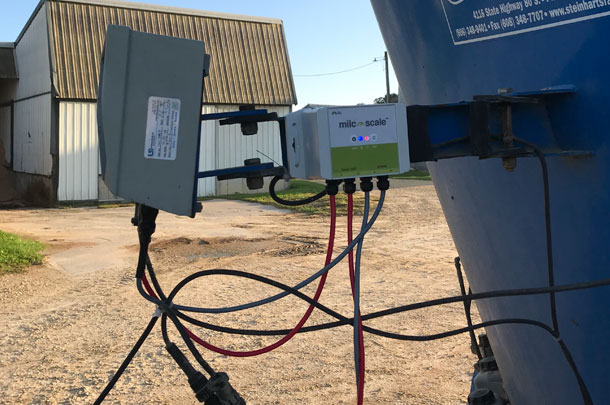
$100,000 giveaway
One company was giving away up to $100,000 in new equipment during World Dairy Expo. The milc group, a consulting and dairy technology company, had its new feed management hardware and software “one feed” on display. Customers who signed up for a subscription to the new feed management software were eligible for free equipment, up to a $2,000 value.
The scale monitoring hardware operates off of Bluetooth technology and syncs with Apple and Android devices. The company claims it is the only mix monitoring system that will work with any brand of mixer.
The tablet-sized hardware connects directly to the mixer’s junction box and relays mixing instructions and mixing accuracy to the operator’s cell phone mounted for easy viewing in the cab of a tractor or front-end loader. A countdown shows the operator in real time how much of a feed ingredient needs to be loaded and guides the operator in the correct mixing order. Reports for each mix and load-out by the operator are available in real time, as the data syncs using the cell phone’s data connection to a cloud-based database.
The company’s giveaway will continue throughout October. The first 50 customers who sign up for the system will receive free equipment for one mixer-loader pair.
—Editor Walt Cooley
PHOTO: Milc scale is the first mix monitoring system that will work with any brand of mixer. The weight data from the mixer is relayed via Bluetooth connection to the cab of the loader or tractor for the loader operator to know how much more of each mix ingredient to add. Photo courtesy of milc.

‘Hats off to women in agriculture’
In a celebration of females working in various aspects of dairy farming, the Save Cows company included a special display to honor women in agriculture. The entire booth featured a purple-colored theme, and one area was designated specifically to highlighting five women and their stories of forging the way for females in the industry. “We like to support young women in industry and business,” Save Cows CEO Melanie Burgi said. Also, women who stopped by during the show could don a festive hat for a photo opportunity, and they received special gifts, including purple sunglasses and a packet of notecards with a copy of a beautiful, hand-painted dairy farm scene, complete with a woman overlooking her herd.
The efforts were well received by expo attendees. “We created this forum for women to share what they do,” Burgi added. “The women are embracing this, and the men too.”
—Editor Peggy Coffeen
PHOTO: Photo by Peggy Coffeen.
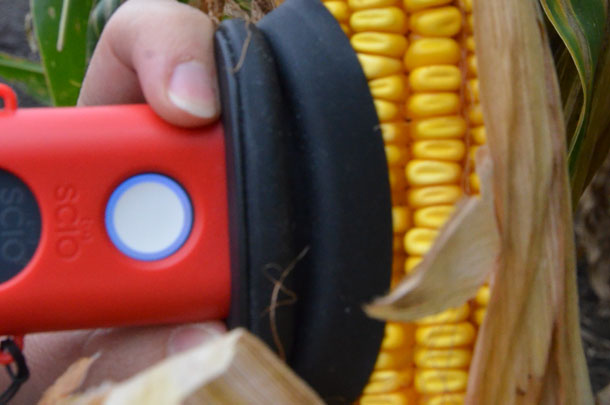
Smaller, faster, efficient feed analysis
Agricultural technology equipment and applications keep getting smaller, faster and more affordable for on-farm use.
Demonstrated next to World Dairy Expo’s forage displays and seminars, SCiO’s Pocket Feed Analyzer utilizes near-infrared (NIR) spectroscopy to analyze forage (silages and dry hay), total mixed ration (TMRs) and grain samples, with capabilities to provide information on such things as dry matter content, moisture, protein and more. When shared with dairy farm agronomy and nutrition advisers and managers, the information enables dairy farmers to make timely and efficient crop harvest, storage and feeding decisions.
The pocket-sized scanner connects wirelessly to the SCiO App on your smart device. Information is saved digitally, and scan history and results are available within the app and are easily sharable through email and messaging, and can be imported into multiple feed management systems.
Find more information at the SCiO website.
—Editor Dave Natzke
PHOTO: Photo courtesy of SCiO.
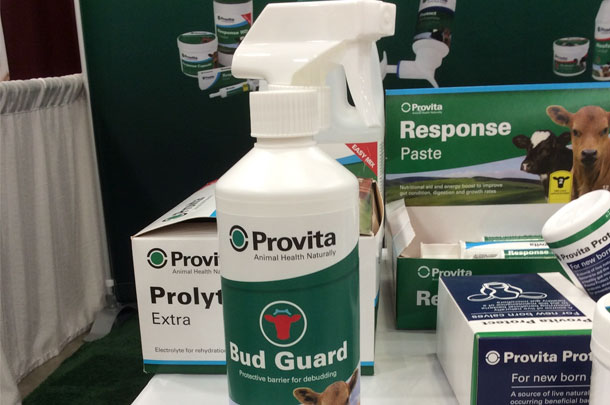
Spray-on Band-Aid for dehorning calves
Bud Guard, a product by Provita, is a spray-on, protective barrier for calves that have recently been dehorned or disbudded. Once it dries for one to two minutes, the barrier becomes a waterproof, breathable, flexible film that will eventually slough off on its own. The product is antibiotic-free and made up of organic acids and essential herb oils, giving it natural antibacterial and antifungal properties. For those who group house calves, this product is also safe should a curious calf decide to lick it off one of its herdmates; however, provided it has been allowed to dry for a couple of minutes, the barrier should stay in place on the calf.
—Editor Jenna Hurty-Person
PHOTO: Photo by Jenna Hurty-Person.
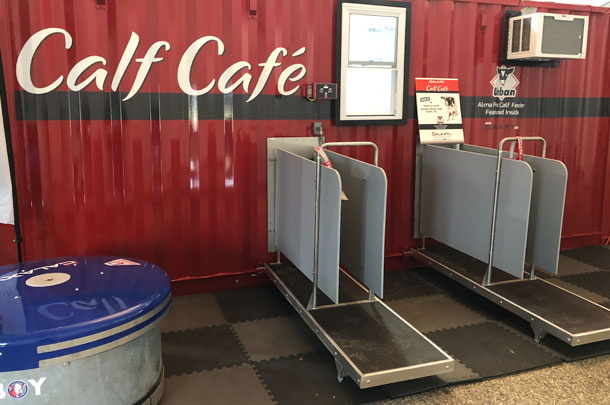
A cafe for calves
If you entered the New Holland Pavilion, you couldn’t miss the big, red, recycled shipping container in the AMS Galaxy USA booth. The half-a-semi-trailer-sized container had been converted into an automated calf feeder hut capable of feeding up to 200 calves. Up to eight feeding nipples, each capable of feeding up to 25 calves, can be installed on each side of this new innovation, says AMS Galaxy owner and Pennsylvania dairyman Bradley Biehl. The model on display had only four drinks stations (two per side) and was designed to feed 100 calves. The container itself is known as a ‘one-tripper,’ a storage unit used for one-way imports from China to the U.S. A client had already purchased three of the feeding stations like the one on display, which Biehl has nicknamed the “Calf Cafe.” The first-ever units will be placed in drylot calf pens in California that already have shades and a feedline.
—Editor Walt Cooley
PHOTO: The inside and outside of a recycled shipping container turned automated calf feeding station. Up to four feeding nipples per side can be installed to feed up to 200 calves per container, says AMS Galaxy owner and dairyman Bradley Biehl. The model on display had only four drinks stations (two per side) and was designed to feed 100 calves. Photo by Walt Cooley.

HoloLens glasses – first augmented reality application in agriculture
Last year at World Dairy Expo, the future vision for dairy management was presented in a meeting with Nedap. An entire year later and one step closer, the company paired their CowControl system that monitors each cow’s behavior and her real-time location with Microsoft’s HoloLens glasses. This year, expo goers had the opportunity to wear and interact with the augmented reality technology. Insights such as heat or fertility, health information and the location of individual cows are presented within the farmer’s field of view behind the glasses. The information is shown above the cows and automatically adapts to the farmer’s location in the barn and responds to the direction in which he or she looks. As a result, the farmer automatically receives the right information at the right time and place over the correct cow when walking pens in the barn. Actions can be performed and registered in the system using hand gestures and voice commands and is entered into the farm management system automatically. This means the limitations of clipboards and handheld devices are eliminated, allowing the farmer to interact with information and have both hands free for other tasks. Depending on the task that you are performing, the system really thinks with you. May that task be a vet check, there is no need for a second person giving you information and no administration afterward entering treatment information into your computer. Once the glasses are made more durable and farm-proof, the technology will be available for sale.
Find more information in this video.
—Editor Audrey Schmitz
PHOTO: Photo provided by Audrey Schmitz.

Udder Comfort backpack sprayer
The team at Udder Comfort introduced a specially equipped backpack sprayer as another way to apply their products. It has the same spray-wand capability as the company’s spray gun used in a parlor setting, but it doesn’t need an air supply, which makes it portable to any location on the farm.
With this tool, dairy producers can better customize their pre-fresh and post-fresh applications of udder conditioning products.
Mart Prost with Udder Comfort explained producers can take it to the pre-fresh pen for applications of sprayable lotions to the udder twice a day a couple of days prior to freshening and continue in the barn or parlor for a few days after calving. Test cases have shown reduced edema, a lesser chance of mastitis because teats close faster and calmer cows at their first milkings.
Chuck Worden, a dairy producer from Wormont Dairy in Cassville, New York, said, “It’s a way big dairymen can work with the product.”
—Editor Karen Lee
PHOTO: Photo by Karen Lee.
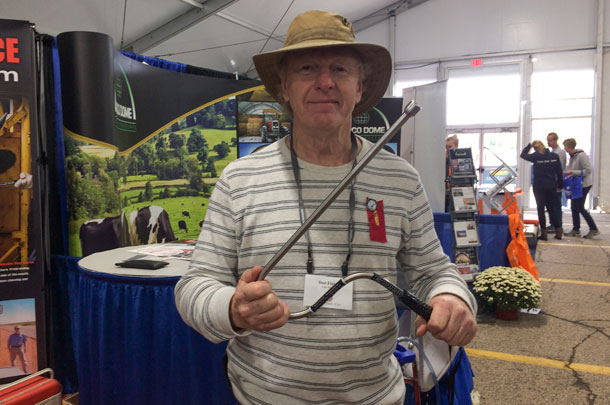
Oral distraction tool reduces fear and stress in cattle
The Easy Boss E is a new oral distraction tool designed to reduce fear and stress in animals. The product is made of stainless steel tubing and stimulates the animal’s natural chewing behavior, which helps to calm the animal and make it move around less and be more docile. In addition, oral (liquid) medicine can be administered through the tube. Finally, the product is designed so it can easily be used by a man, woman or even a child.
—Editor Jenna Hurty-Person
PHOTO: Photo by Jenna Hurty-Person.

Cinnatube – all-natural dry cow tube
Making its debut, Cinnatube, a new one-shot, non-antibiotic, all-natural dry cow teat infusion, was in high demand last week at World Dairy Expo. The paste includes only GRAS/FEMA-GRAS ingredients, eliminating the risk of antibiotic residues in milk. The teat sealant imitates the cow’s natural defense, the keratin plug, during the dry cow period. It provides a safe, non-antibiotic, physical barrier between the udder and environment, and prevents bacteria from entering the udder through the teat sphincter and teat canal. The paste is OMRI listed and can be used in organic dairy milk production. USDA-funded trials showed the single-shot dry cow tube was as effective as the two-shot Quartermaster and Orbseal combination in preventing new cases of mastitis during the dry period, guaranteeing no risk of antibiotic residue.
—Editor Audrey Schmitz
PHOTO: Photo provided by Audrey Schmitz.
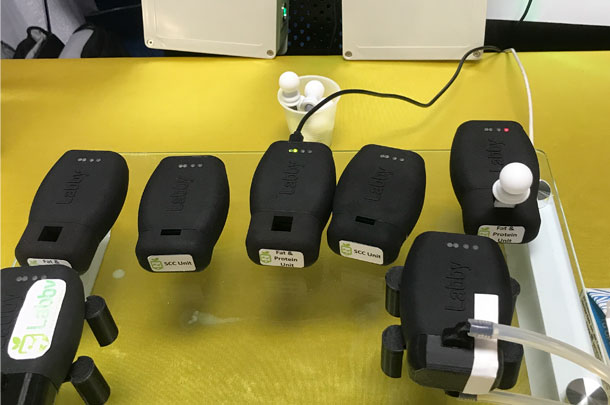
Milk analyzer – fat, protein and SCC
Founded in 2017 at MIT, Labby is a dairy information and data company developing real-time raw milk testing solutions for dairy farmers to improve milk production and profitability. This year at expo, the company presented their in-line and stand-alone milk analyzers. These products provide on-site milk testing solutions to farmers and dairy co-ops that are reliable and accurate in under 10 seconds. The portable milk analyzer can perform bulk tank and individual cow testing of fat, protein and somatic cell count (SCC) at the farm level using light scattering, absorption and fluorescence to simultaneously determine milk composition. Their user interface is compatible with smartphones and tablets, where farmers can instantly visualize results. No more waiting once a month to receive individual cow milk reports.
—Editor Audrey Schmitz
PHOTO: Photo provided by Audrey Schmitz.
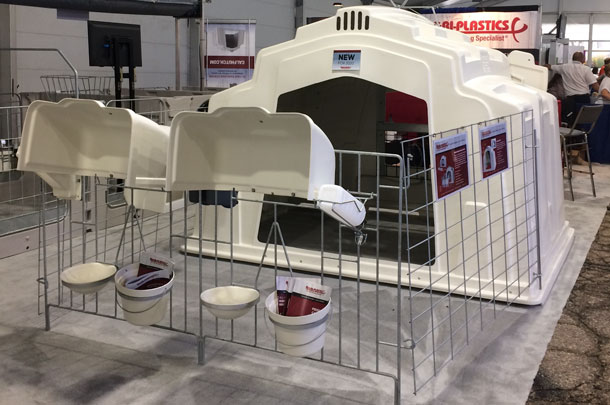
A hutch that’s built for two calves
Agriplastics introduced their latest creation, a hutch that is designed for pair housing calves, which can help reduce weaning stress and promote feed consumption and socialization. The hutch, which the company is calling the Buddy Hutch, is similar to the company’s Group Hutch, but it has a few modifications for newborn calves. These modifications include a lower door height to minimize drafts, a rear door grid guard and multiple vents, including a grill vent in the front and a rear top rotary vent for airflow control.
—Editor Jenna Hurty-Person
PHOTO: Photo by Jenna Hurty-Person.

Paul Mueller Company milk tower
Vertical silos have been used to store milk for more than 30 years in the western part of the U.S. Now, market conditions are proving a need for this style of on-site storage in the Midwest and eastern regions, as well as Canada.
The new Mueller milk tower is available in six sizes, ranging from 7,000 to 40,000 gallons. It offers increased storage capacity on a smaller footprint. This dramatically reduces construction costs with just a stainless steel alcove as the only component needed inside the milk house wall, said Mike Kelley, dairy farm equipment regional sales manager for Canada.
The larger capacity, coupled with no interruption of milking to empty it, offers more flexibility for milk haulers, which can lead to reduced transportation costs for the farm.
—Editor Karen Lee
PHOTO: Photo by Karen Lee.
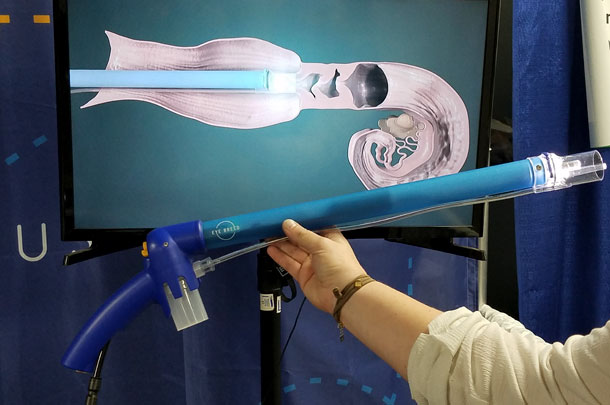
Insemination without palpation
French company AXCE introduced the Eye Breed at World Dairy Expo – a new, less invasive way of inseminating cows. This tool deposits semen in the uterine body without the need for rectal palpation. The gun-like probe is inserted into the heifer or cow’s reproductive tract, and a camera at the end relays a real-time view of the cervix directly to a smart phone. Slight suction is used to establish contact between the cervix and the tool. An A.I. breeding gun is inserted into the Eye Breed to deliver semen. The company that distributes this technology touts its animal welfare benefits and ease of training and use. ![]()
—Editor Peggy Coffeen
PHOTO: Photo by Peggy Coffeen.
COVER PHOTO: Last week, the dairy industry convened in Madison, Wisconsin, for the World Dairy Expo. The soggy week left only a few breaks for sunshine, but despite the gray skies, those who attended left with images of a brighter future for dairy ahead. Photo by Peggy Coffeen.






